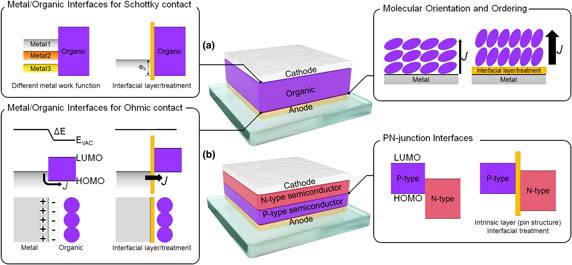Crossref Citations
This article has been cited by the following publications. This list is generated based on data provided by
Crossref.
Wang, Xiaoxue
Zhang, Xu
Sun, Lei
Lee, Dongwook
Lee, Sunghwan
Wang, Minghui
Zhao, Junjie
Shao-Horn, Yang
Dincă, Mircea
Palacios, Tomás
and
Gleason, Karen K.
2018.
High electrical conductivity and carrier mobility in oCVD PEDOT thin films by engineered crystallization and acid treatment.
Science Advances,
Vol. 4,
Issue. 9,
Martínez-Domingo, Carme
Conti, Silvia
Terés, Lluís
Gomes, Henrique Leonel
and
Ramon, Eloi
2018.
Novel flexible inkjet-printed Metal-Insulator-Semiconductor organic diode employing silver electrodes.
Organic Electronics,
Vol. 62,
Issue. ,
p.
335.
Kang, Chan-Mo
Roh, Jeongkyun
Shin, Hyeonwoo
Lee, Changhee
and
Lee, Hyunkoo
2019.
Investigation of Improved Performance for Organic Rectifying Diodes via Electrical Annealing.
IEEE Access,
Vol. 7,
Issue. ,
p.
84082.
de Lima Citolino, Lucas Vinicius
Assunção da Silva, Edilene
and
de Almeida Olivati, Clarissa
2019.
Hybrid and pristine polyalkylthiophene Langmuir-Schaefer films: Relationships of electrical impedance spectroscopy measurements, barrier properties and polymer nanostructure.
Materials Science in Semiconductor Processing,
Vol. 91,
Issue. ,
p.
296.
Li, Tianming
Bandari, Vineeth Kumar
Hantusch, Martin
Xin, Jianhui
Kuhrt, Robert
Ravishankar, Rachappa
Xu, Longqian
Zhang, Jidong
Knupfer, Martin
Zhu, Feng
Yan, Donghang
and
Schmidt, Oliver G.
2020.
Integrated molecular diode as 10 MHz half-wave rectifier based on an organic nanostructure heterojunction.
Nature Communications,
Vol. 11,
Issue. 1,
Yun, Dong-Jin
Yun, Youngjun
Lee, Jiyoul
Kim, Joo-Young
Chung, JaeGwan
Kim, Seong Heon
Kim, Yong-Su
Heo, Sung
Park, Jeong-Il
Kim, Ki-Hong
Kwon, Young-Nam
and
Chung, Jong Won
2020.
In-Depth Investigation of the Correlation between Organic Semiconductor Orientation and Energy-Level Alignment Using In Situ Photoelectron Spectroscopy.
ACS Applied Materials & Interfaces,
Vol. 12,
Issue. 45,
p.
50628.
Sergi Lopes, Carolina
Merces, Leandro
de Oliveira, Rafael Furlan
de Camargo, Davi Henrique Starnini
and
Bof Bufon, Carlos César
2020.
Rectification ratio and direction controlled by temperature in copper phthalocyanine ensemble molecular diodes.
Nanoscale,
Vol. 12,
Issue. 18,
p.
10001.
Sawatzki, Michael F.
Kleemann, Hans
Boroujeni, Bahman K.
Wang, Shu‐Jen
Vahland, Joern
Ellinger, Frank
and
Leo, Karl
2021.
Doped Highly Crystalline Organic Films: Toward High‐Performance Organic Electronics.
Advanced Science,
Vol. 8,
Issue. 6,
Ganguly, Sudin
and
Maiti, Santanu K.
2022.
Efficient current rectification in driven acenes.
Physical Chemistry Chemical Physics,
Vol. 24,
Issue. 46,
p.
28436.
Kim, Chang-Hyun
2022.
Evidence of ambient doping in pentacene rectifying diodes.
AIP Advances,
Vol. 12,
Issue. 1,
El-Mahalawy, Ahmed M.
Abdrabou, Mahmoud M.
Mansour, S. A.
and
Ali, Fayez M.
2023.
Mechanistic exploration of charge transport and photosensitivity of metal/polymer/semiconductor (MPS) junction for sensitive light detection applications.
Journal of Materials Science: Materials in Electronics,
Vol. 34,
Issue. 36,
Sawatzki-Park, Michael
Wang, Shu-Jen
Kleemann, Hans
and
Leo, Karl
2023.
Highly Ordered Small Molecule Organic Semiconductor Thin-Films Enabling Complex, High-Performance Multi-Junction Devices.
Chemical Reviews,
Vol. 123,
Issue. 13,
p.
8232.
Jana, Subhajit
Kumari, Nikita
Pandey, Shyam S.
and
Prakash, Rajiv
2023.
Improving vertical charge transport in organic Schottky diodes via interface engineering of large-area conducting polymer thin films fabricated on hydrophilic liquid surface of tunable surface energy.
Applied Surface Science,
Vol. 616,
Issue. ,
p.
156377.
Imroze, Fiheon
Chennamkulam Ajith, Mithun
Manda, Prashanth Kumar
Logesh, Karunakaran
and
Dutta, Soumya
2024.
Influence of gate dielectric property on the capacitance dispersion in organic-metal-insulator-semiconductor capacitors.
Journal of Physics D: Applied Physics,
Vol. 57,
Issue. 28,
p.
285101.
Nguyen, Quang Tan
Tran, Van Tam
Vu, Duy Linh
Le, Chau Duy
Choi, Won Mook
and
Ahn, Kyoung-Kwan
2024.
Tribo-hygro-electric generator: Harnessing mechanical energy with liquid-infused porous cellulose for multiple sensing and DC power generation.
Nano Energy,
Vol. 132,
Issue. ,
p.
110353.
Ihnatsenka, S.
2024.
Interface effects on the thermoelectric properties of disordered semiconductors.
Physical Review B,
Vol. 110,
Issue. 21,
Cho, Hong-rae
Hyung Park, Joon
Kim, Somi
Udaya Mohanan, Kannan
Jung, Sungyeop
and
Kim, Chang-Hyun
2024.
Impedance characterization of dinaphtho[2,3-b:2’,3’-f]thieno[3,2-b]thiophene diodes: Addressing dielectric properties and trap effects.
Journal of Applied Physics,
Vol. 135,
Issue. 17,



